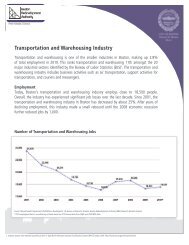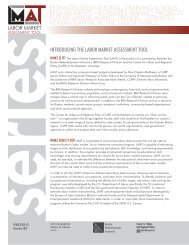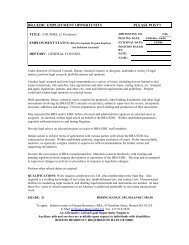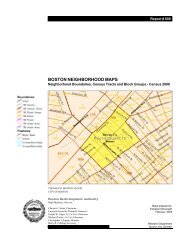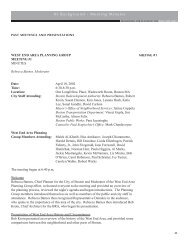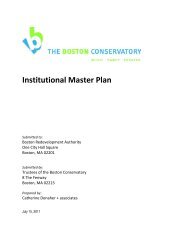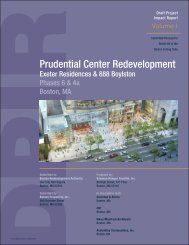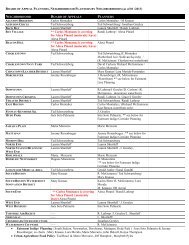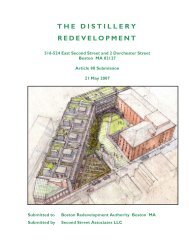point cover jan 13 - Boston Redevelopment Authority
point cover jan 13 - Boston Redevelopment Authority
point cover jan 13 - Boston Redevelopment Authority
Create successful ePaper yourself
Turn your PDF publications into a flip-book with our unique Google optimized e-Paper software.
\\MABOS\projects\1<strong>13</strong>81.00\reports\Article80\<br />
Expanded_PNF\04_Environmental_FINAL.do<br />
c<br />
Vanasse Hangen Brustlin, Inc.<br />
The Point, <strong>Boston</strong><br />
Pollutants of Concern and Attainment Status<br />
Air pollution is of concern because of its demonstrated effects on human health, in particular the respiratory<br />
effects of the pollutants and their potential toxic effects, as described below.<br />
Carbon Monoxide<br />
Carbon monoxide is a colorless and odorless gas that is a product of incomplete combustion. Carbon<br />
monoxide is absorbed by the lungs and reacts with hemoglobin to reduce the oxygen carrying capacity of the<br />
blood. At low concentrations, CO has been shown to aggravate the symptoms of cardiovascular disease. It<br />
can cause headaches and nausea and, at sustained high concentration levels, can lead to coma and death.<br />
<strong>Boston</strong> is a CO Maintenance area. A Maintenance area is an area that formerly was non-attainment, but, has<br />
demonstrated that the air quality has improved to attainment. After 20 years of clean air quality, Maintenance<br />
areas can be re-designated to attainment. Projects located in Maintenance areas, as The Point Project currently is,<br />
are required to evaluate their CO concentrations on the NAAQS.<br />
Particulate Matter<br />
Particulate matter is made up of small, solid particles and liquid droplets. PM10 refers to particulate matter with<br />
a nominal aerodynamic diameter of 10 micrometers or less, and PM2.5 refers to particulate matter with an<br />
aerodynamic diameter of 2.5 micrometers or less. Particulates can enter the body through the respiratory<br />
system. Particulates over 10 micrometers in size are generally captured in the nose and throat and are readily<br />
expelled from the body. Particles smaller than 10 micrometers, and especially particles smaller than<br />
2.5 micrometers, can reach the air ducts (bronchi) and the air sacs (alveoli) in the lungs. Particulates are<br />
associated with increased incidence of respiratory diseases, cardiopulmonary disease, and cancer.<br />
<strong>Boston</strong> is currently in attainment/unclassifiable for PM10 and PM2.5. An attainment/unclassifiable area is an area<br />
that does not yet have sufficient data to determine its attainment status. The EPA and Federal Highway<br />
Administration (FHWA) are in the process of developing modeling guidance for attainment/unclassifiable areas.<br />
This air quality evaluation included a microscale analysis to demonstrate compliance with the NAAQS.<br />
<br />
Air Quality Standards<br />
The EPA has set the NAAQS to protect the public health. The NAAQS for CO, PM10, and PM2.5 are presented<br />
in Table 4-2. The predominant source of air pollution anticipated from the Project is emissions from<br />
Project-related motor vehicle traffic. Carbon monoxide, PM10, and PM2.5 are directly emitted by motor<br />
vehicles. Their concentrations can be calculated and compared to the NAAQS.<br />
4-16 Environmental Protection



